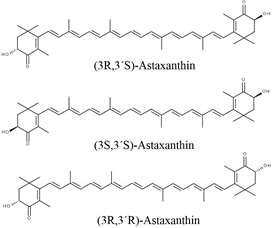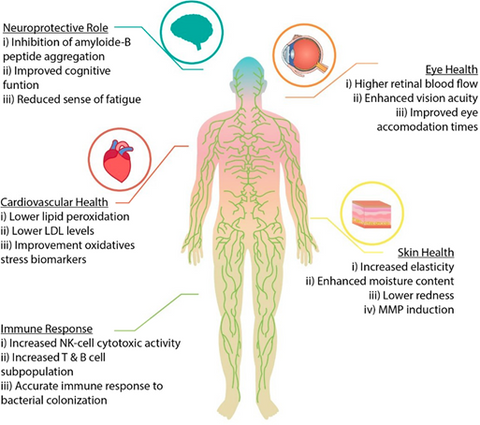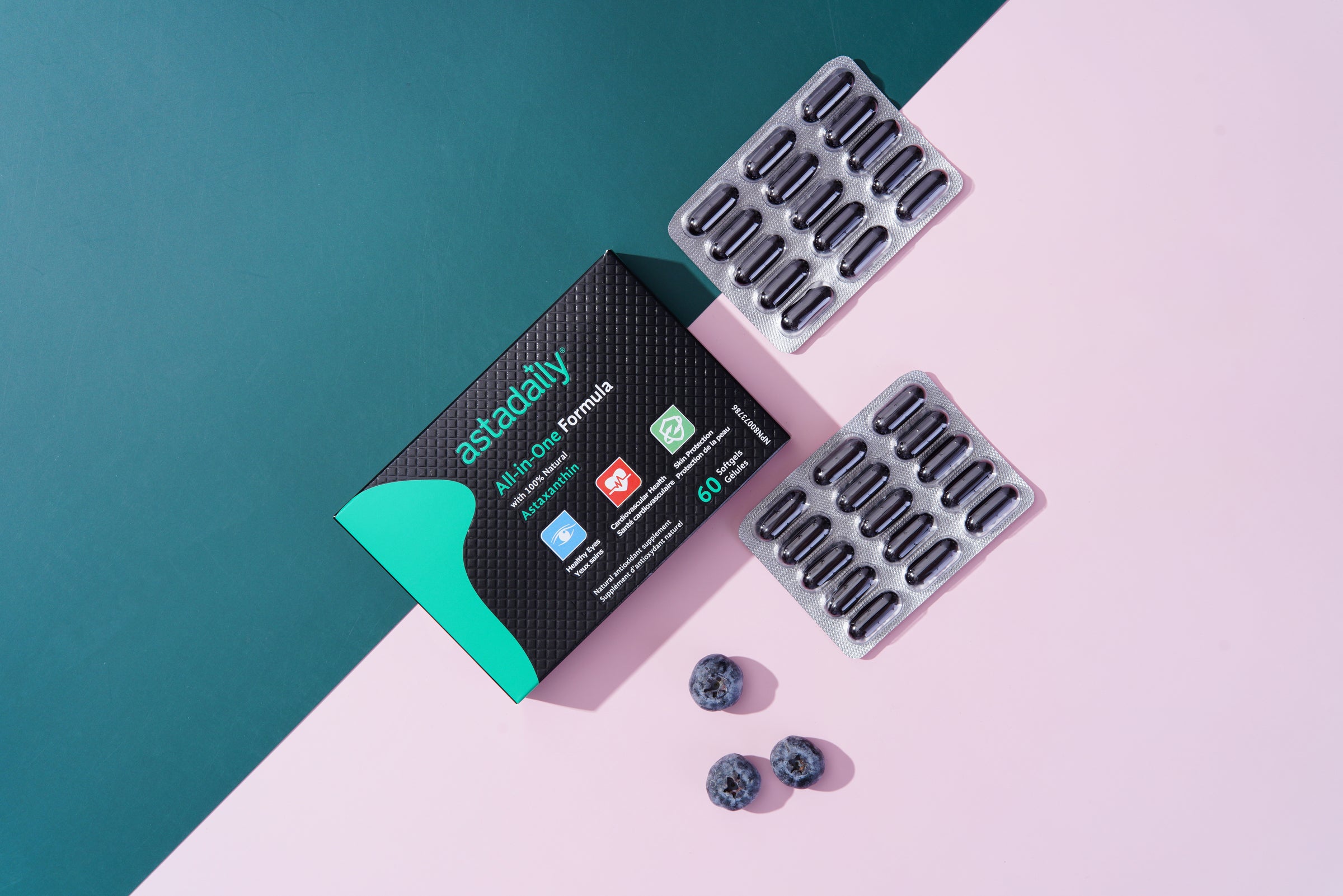Astaxanthin and Its Promising Health Benefits

Have you heard of astaxanthin? It's a natural substance that's found in some foods and has some really impressive health benefits. It's a powerful antioxidant nutrition, which means it can help protect your body from harmful substances. Some studies have shown that it can help improve your heart health and your immune system, and it might even be able to protect you from the sun's harmful rays. Astaxanthin has also been shown to boost exercise performance, so it's no surprise that it's become a popular supplement among athletes. In this article, we'll take a closer look at astaxanthin and what it can do for you.
Astaxanthin belongs to a group of pigments known as carotenoids. It is often referred to as “the king of carotenoids” because of its reputation as one of the most potent antioxidants nutrition found in nature. Astaxanthin has been applied widely in the food, feed, cosmetic, aquaculture, nutraceutical, and pharmaceutical industries. It can significantly reduce free radicals and oxidative stress and help the human body maintain a healthy state.
1. What Is Astaxanthin?
Astaxanthin (3,3′dihydroxy-ß-carotene-4,4′-dione) is a bright red secondary carotenoid from the same family as lycopene, lutein, and β-carotene and is often called a “super antioxidant.” According to research, astaxanthin is more than 65 times more effective than vitamin C and 50 times more potent than vitamin E when protecting cell membranes. When removing free radicals, it is 6,000 times stronger than vitamin C and 550 times stronger than vitamin E.1
Astaxanthin contains two asymmetric carbon atoms at positions 3 and 3' and can exist in three different stereoisomers: 3S, 3′; 3R, 3′S; and 3R, 3′R (Fig. 1). The chemical synthesis of this compound yields a ratio of 1:2:1 for these isomers. However, isomers with a chirality 3S, 3'S or 3R, 3'R are dominant in nature and are considered to have higher bioavailability. Over 85% of astaxanthin from microalgae exists in the form of 3S, 3'S, which has the highest reported antioxidant activity of all three forms.

Fig. 1. Stereoisomers of astaxanthin2
2. How Does Astaxanthin Work?
Antioxidants nutrition are agile molecules that repair cellular-level damage caused by unstable and harmful molecules called free radicals. In our bodies, these molecules are constantly being released during metabolism. Unfortunately, uncontrollable free radicals can destroy good cells as well. The body requires a subtle balance between free radicals and antioxidants, and antioxidants like astaxanthin work to keep free radicals in check.
Astaxanthin’s potent antioxidant effects are due to its unique molecular structure, which contains conjugated double bonds and hydroxyl and keto groups. The conjugated double bonds at its center are responsible for its red colour and—most importantly—its high antioxidants nutrition capacity as it donates electrons via the carbon–carbon chain, which is analogous to a conducting wire at the molecular level (Fig. 2). With the help of astaxanthin, excessive electrons generated by ultraviolet radiation within the cell can be transported through the membrane, thus blocking free radical chain reactions.

Fig 2. Electrons crossing the cell membrane via 3S, 3S’ astaxanthin, the major molecular form from H. pluvialis3
3. Sources of Astaxanthin
Astaxanthin can be obtained from both synthetic and natural sources. Phaffia yeast and Paracoccus bacteria, krill, and some microalgae are sources of natural astaxanthin and are present in much of the seafood we eat (0.02% of cell dry weight approximately), including salmon, trout, red sea bream, shrimp, lobster, and fish eggs. Freshwater microalgae Haematococcus Pluvialis is the richest (3-4% of cell dry weight) source of natural astaxanthin and the primary producing organism of this commercial product. The human body cannot produce astaxanthin on its own, so we have to get it through seafood or dietary supplements.
3.1. Synthetic vs. Natural Astaxanthin
Synthetic astaxanthin has an antioxidant capacity 20 times lower than that of its natural counterpart (H. Pluvialis) and, to date, has not been approved for human consumption. Moreover, there are concerns about the safety of using synthetic astaxanthin for direct human consumption due to differences in stereochemistry and potential carryover of synthesis intermediates. These concerns make natural astaxanthin from H. Pluvialis a preferred choice for high-end markets. Oxygen Radical Absorbance Capacity (ORAC) values for H. Pluvialis-made astaxanthin are about three times higher than those of the synthetic product and nearly a third higher than those of the yeast-made version. H. Pluvialis has already been approved as a dietary supplement ingredient for human consumption in North America, Japan, and several European countries.
3.2. How Do We Get Astaxanthin From H. pluvialis?
The life cycle of H. pluvialis consists of two stages: the green motile and red non-motile stage. In the red stage, the cell appears in the haematocyst, wherein astaxanthin is accumulated. H. Pluvialis, under stressed conditions such as ultraviolet radiation, experiences cellular and metabolic transformation. The astaxanthin gets deposited in lipid droplets in the cytoplasm, giving the cell a reddish colour pigment. Unfortunately, the accumulation of astaxanthin within H. pluvialis is strongly linked to the cell’s rigid wall, which is extremely resistant to both chemical and physical disruptions. Without cell disruption, only about 20% of astaxanthin is accessible in the extraction process. Chemical disruption using acids (10 times stronger than gastric acid) or bases typically results in low (< 40%) extraction efficiencies. Therefore, direct consumption of intact H.p cells offers limited bioavailability of astaxanthin from the cell. Effective cell wall disruption and astaxanthin extraction techniques are critical to the amount and quality of the final product. Iconthin Biotech was founded by Dr. Alvin Cheng during his Ph.D. in Mechanical and Industrial Engineering at the University of Toronto. His research brings unique insights into astaxanthin extraction method that can efficiently removes the valuable antioxidant from the microalgae Haematococcus pluvialis, superior to conventional methods in terms of extraction efficiency and recovery rate (Fig. 3). As the foremost leader in the astaxanthin supplement industry, Iconthin is leading the way in creating standards for the formulation, processing, and transportation of astaxanthin supplements.

4. Health Benefits of Astaxanthin
Astaxanthin nutrition is essential for human growth, health, and wellness. It helps to reduce oxidation, which is responsible for the vast majority of inflammation in our bodies. Inflammation is responsible for early aging, brain-related conditions like dementia, eye problems, heart disease, arthritis, and an array of cancers.
Plenty of published information is available with evidence, mainly from in vitro and animal studies, of astaxanthin’s benefits for treating various types of cancer, cardiovascular disease, age-related ocular deterioration, and neurodegenerative diseases (Fig. 4). In most double-blind, randomized, controlled trials, maximal health benefits are achieved by taking 12 mg or less of natural astaxanthin per day.

4.1. Astaxanthin Promotes Skin Health
Oxidative stress can damage our skin's structural and functional proteins, speeding up the aging process and causing inflammation. External damage (UV radiation) causes skin wrinkles, hyperpigmentation, and sometimes cancer. Clinical trials have repeatedly demonstrated that astaxanthin can significantly improve human facial skin conditions, including wrinkling (anti-aging), pigmentation, and transepidermal water loss, as well as retain skin elasticity 5 and inhibit the development of skin cancer 6.
4.2. Astaxanthin Promotes Eye Health
Oxidative damage has been reported to play an essential role in several eye diseases such as age-related macular degeneration (age-related vision loss), cataracts, uveitis, retinopathy of prematurity, corneal inflammation, and keratitis. The intake of natural astaxanthin may help to improve retinal blood flow, vision acuity, and uveitis 7, reduce oxidative stress, and promote retinal ganglion cell survival 8.
4.3. Astaxanthin Improves Cardiovascular Health
Oxidative stress and inflammation are correlated and implicated in the initial progression of cardiovascular diseases, including dyslipidemia and hypertension. Astaxanthin supplementation can be beneficial for people with an increased risk for heart attacks. It is carried by very low-density lipoprotein (VLDL), low-density lipoprotein (LDL), and high-density lipoprotein (HDL) in human blood and protects LDL cholesterol against oxidation 9; it also increases basal arterial blood flow 10. A recent study shows that astaxanthin supplementation can significantly reduce oxidative stress and improve cardiac contractility (the strength of the heart's contraction) and exercise tolerance 11.
4.4. Astaxanthin Protects Neurological Function
Astaxanthin can cross the blood-brain barrier in mammals and extend its antioxidant benefits beyond that barrier. Therefore, it can help to alleviate the effects of Alzheimer's disease and Parkinson's disease 12. A recent study shows that astaxanthin improves composite memory and verbal memory scores on the Cognitrax cognitive test and also improves subjective symptoms of memory 13.
4.5. Astaxanthin Enhances Exercise Performance
Astaxanthin can be used as a dietary supplement for athletes. Research conducted on the effect of astaxanthin supplements on endurance athletes demonstrates improved performance and enhanced whole-body fat oxidation rates in a group of male cyclists taking astaxanthin for a week 14.
4.6. Astaxanthin Improves Immune Response
The immune system functions like the police force of our body. It serves as your first -- and possibly only -- line of defence against viruses, bacteria, and other intruders. Diseases can easily enter your body and cause irreversible health damage if your immune system does not respond quickly. Astaxanthin can reduce oxidation, decrease DNA damage, and improve the immune response 15. Recently, researchers found that astaxanthin can prevent damage in the intestinal mucosa and maintain a healthy body weight16.
4.7. Astaxanthin Controls the Growth of Cancer Cells
There are a lot of people suffering from various types of cancers around the globe. Astaxanthin could be a promising candidate to treat and prevent breast cancer 17, cell death, cell proliferation, and mammary tumours 18.
4.8. Astaxanthin Helps to Treat Fatty Liver Disease
Protecting the liver against damage, such as non-alcoholic fatty liver disease, is now thought to be vital for the prevention of unfavourable illnesses such as cardiovascular and cancerous diseases. Studies have shown that astaxanthin has important preventive and therapeutic effects on liver fibrosis, non-alcoholic fatty liver disease, liver cancer, drug and ischemia-induced liver injury. Its mechanism is related to antioxidant and anti-inflammatory activities and the regulation of multiple signalling pathways 19
4.9. Astaxanthin Helps to Manage Ulcers
As the body's most delicate component, a healthy digestive system is essential to living a healthy lifestyle. Helicobacter pylori is a very damaging bacteria that is typically located in the stomach. It initially manifests as chronic gastritis and stomach ulcers. Astaxanthin helps to fight against gastric lesions (ulcers) 20 and improve gastrointestinal health 21.
4.10. Astaxanthin Prevents and Reduces Brain Damage from Stroke
Astaxanthin can also prevent and reduce brain damage from stroke by stimulating blood flow, lowering blood pressure, relaxing blood vessels, and reducing oxidative stress. Research shows that high doses of astaxanthin reduce stroke-related brain damage and also reduce neurotoxicity caused by nitric oxidation 22.
4.11. Astaxanthin Boosts Male Fertility
Astaxanthin can help solve the problem of male infertility. In one study, 30 men suffering from infertility problems were treated with astaxanthin for three months. The group given the highest dose of astaxanthin demonstrated significant improvement in sperm count and motility and improved fertility 23.
4.12. Astaxanthin Reduces Inflammation
Astaxanthin can act on reactive oxygen species to minimize proteins that cause inflammatory diseases like rheumatoid arthritis and osteoarthritis. Research shows that astaxanthin maintains cartilage homeostasis and mitigates the effects of arthritis by blocking inflammation, oxidative stress, and cell damage 24.
4.13. Astaxanthin Helps with Diabetes
Astaxanthin can protect pancreatic beta cells by reducing oxidative stress and glucose toxicity, thus helping to manage diabetes mellitus. Researchers discovered that astaxanthin reduced glucose toxicity in diabetic mice and protected their pancreatic beta cells 25. This suggests that astaxanthin could help to lower high blood pressure and improve glucose metabolism in patients with type 2 diabetes 26.
Long-term administration of astaxanthin is much more likely than short-term administration to exert greater physiological regulation under excess amounts of oxidative stress or in immunocompromised individuals.
5. Summary
- Astaxanthin is a bright red secondary carotenoid from the same family as lycopene, lutein, and β-carotene. It is called a "super antioxidant."
- Astaxanthin's antioxidant properties are important for human growth, health, and wellness.
- Freshwater microalgae Haematococcus Pluvialis is the richest source of natural astaxanthin and the primary producing organism of this commercial product.
- Efficient cell wall disruption and intracellular extraction processes are critical to the effectiveness of astaxanthin obtained from microalgae.
- Astaxanthin offers various human health benefits and nutraceutical applications. Plenty of published evidence is available, mainly from in vitro and animal models, and research should be continued to discover more benefits of astaxanthin.
- Natural astaxanthin production is still costly, but scientists have been working to make it economically viable.
Astaxanthin Supplements
Bibliography
1. Shah, M.M.R., Liang, Y., Cheng, J.J., & M. Daroch, M. Astaxanthin-producing green microalgae Haematococcus pluvialis: from single cell to high value commercial products. Front. Plant Sci. 7 (2016).
2. Donoso, A., González-Durán, J., Muñoz, A. A., González, P. A., & Agurto-Muñoz, C. Therapeutic uses of natural astaxanthin: An evidence-based review focused on human clinical trials. Pharmacol Res. 166, 105479 (2021).
3. Pashkow, F.J., Watumull, D. G., & Campbell, C. L. Astaxanthin: a novel potential treatment for oxidative stress and inflammation in cardiovascular disease. Am J Cardiol.101, 58-68 (2008).
4. Cheng, X., Riordon, J., Nguyen, B., Ooms, M. D. & Sinton, D. Hydrothermal disruption of algae cells for astaxanthin extraction. Green Chem. 19, 106-111 (2017).
5. Cao, Y., Yang, L., Qiao, X., Xue, C, & Xu J. Dietary astaxanthin: an excellent carotenoid with multiple health benefits. Critical Reviews in Food Sci and Nut. (2021).
6. Rao, A.R., Sindhuja, H.N., Dharmesh, S.M., Sankar, K.U., Sarada, R., Ravishankar, G.A. Effective inhibition of skin cancer, tyrosinase, and antioxidative properties by astaxanthin and astaxanthin esters from the green algae Haematococcus pluvialis. J Agric Food Chem. 61, 3842-51 (2013).
7. Giannaccare, G., Pellegrini, M., Senni, C., Bernabei, F. Scorcia, V., & Cicero, A.F.G. Clinical Applications of Astaxanthin in the Treatment of Ocular Diseases: Emerging Insights. Mar. Drugs. 18, 239 (2020).
8. Lin, W.N., Kapupara, K., Wen, Y.T., Chen, Y.H., Pan, I.H., & Tsai, R.K. Haematococcus pluvialis-Derived Astaxanthin Is a Potential Neuroprotective Agent against Optic Nerve Ischemia. Mar. Drugs. 18, 85. (2020)
9. Iwamoto, T., Hosoda, K., Hirano, R., Kurata, H., Matsumoto, A., Miki, W., Kamiyama, M., Itakura, H., Yamamoto, S., & Kondo, K. Inhibition of low-density lipoprotein oxidation by astaxanthin. J Atheroscler Thromb. 7, 216-222 (2000).
10. Miyawaki, H., Takahashi, J., Tsukahara, H., & Takehara, I. Effects of astaxanthin on human blood rheology. J Clin Biochem Nutr 43, 69-74 (2008).
11. Kato, T., Kasai, T., Sato, A., Ishiwata, S., Yatsu, S., Matsumoto, H., Shitara, J., Murata, A., Shimizu, M., Suda, S., Hiki, M., Naito, R., & Daida, H. Effects of 3-Month Astaxanthin Supplementation on Cardiac Function in Heart Failure Patients with Left Ventricular Systolic Dysfunction-A Pilot Study. Nutrients. 1896 (2020).
12. Grimmig, B., Daly L., Subbarayan, M., Hudson, C., Williamson, R., Nash K., & Bickford, P.C. Astaxanthin is neuroprotective in an aged mouse model of Parkinson’s disease. Oncotarget. 9: 10388-10401 (2018).
13. Sekikawa, T., Kizawa, Y., Li, Y., & Takara, T. Cognitive function improvement with astaxanthin and tocotrienol intake: a randomized, double-blind, placebo-controlled study. J. Clinical Biochem. and Nut., 2020, 67, 307-316 (2020)
14. Brown, D.R., Warner, A.R., Deb, S.K., Gough, L.A., Sparks, S.A, & McNaughton LR. The effect of astaxanthin supplementation on performance and fat oxidation during a 40 km cycling time trial. J Sci Med Sport. 24, 92-97 (2021).
15. Park, J. S., Chyun, J. H., Kim, Y.K., Line, L.L. ,& Chew, B.P. Astaxanthin decreased oxidative stress and inflammation and enhanced immune response in humans. Nutrition & Metabolism. 7:18 (2010).
16. Zhang, L., Cao, W., Gao, Y., Yang, R., Zhang, X., & Xu, J. Astaxanthin (ATX) enhances the intestinal mucosal functions in immunodeficient mice. Food Funct. 11, 3371–3381 (2020).
17. McCall B, McPartland CK, Moore R, Frank-Kamenetskii A, Booth BW. Effects of Astaxanthin on the Proliferation and Migration of Breast Cancer Cells In Vitro. Antioxidants (Basel). 7(10), 135 (2018).
18. Nakao, R., Nelson, O.L., Park, J.S, Mathison, B.D., Thompson, P.A., & Chew, B.P. Effect of dietary astaxanthin at different stages of mammary tumor initiation in BALB/c mice. Anticancer Res. 30, 2171-2175 (2010).
19. Li, J., Guo, C., & Wu, J. Astaxanthin in Liver Health and Disease: A Potential Therapeutic Agent. Drug Des Devel Ther. 14, 2275-2285 (2020).
20. Murata, K., Oyagi, A., Takahira, D., Tsuruma, K., Shimazawa, M., Ishibashi, T., & Hara, H. Protective effects of astaxanthin from Paracoccus carotinifaciens on murine gastric ulcer models. Phytother Res. 26, 1126-32 (2012).
21. Kamath, B. S., Srikanta, B. M., Dharmesh, S. M., Sarada, R., & Ravishankar, G. A. Ulcer preventive and antioxidative properties of astaxanthin from Haematococcus pluvialis, European J of Pharmacol. 590, 387-395 (2008).
22. Lu, Y.P., Liu, S.Y., Sun, H., Wu, X.M., Li, J.J., & Zhu, L. Neuroprotective effect of astaxanthin on H(2)O(2)-induced neurotoxicity in vitro and on focal cerebral ischemia in vivo. Brain Res. 1360, 40-8 (2010).
23. Comhaire, F.H., El Garem, Y., Mahmoud, A., Eertmans, F., & Schoonjans, F. Combined conventional/antioxidant "Astaxanthin" treatment for male infertility: a double blind, randomized trial. Asian J Androl. 7, 257-62 (2005).
24. Sun, K., Luo, J., Jing, X., Guo, J., Yao, X., Hao, X., Ye, Y., Liang, S., Lin, J., Wang, G., & Guo, F. (2019). Astaxanthin protects against osteoarthritis via Nrf2: a guardian of cartilage homeostasis. Aging, 11, 10513–10531 (2019).
25. Uchiyama, K., Naito, Y., Hasegawa, G., Nakamura, N., Takahashi, J., & Yoshikawa, T. Astaxanthin protects beta-cells against glucose toxicity in diabetic db/db mice. Redox Rep. 7, 290-3 (2002).
26. Mashhadi, N.S., Zakerkish, M., Mohammadiasl, J., Zarei, M., Mohammadshahi, M., & Haghighizadeh, M.H. Astaxanthin improves glucose metabolism and reduces blood pressure in patients with type 2 diabetes mellitus. Asia Pac J Clin Nutr. 27, 341-346 (2018).







Leave a comment